We Break Down (Most of) the Film References in ‘Nope’
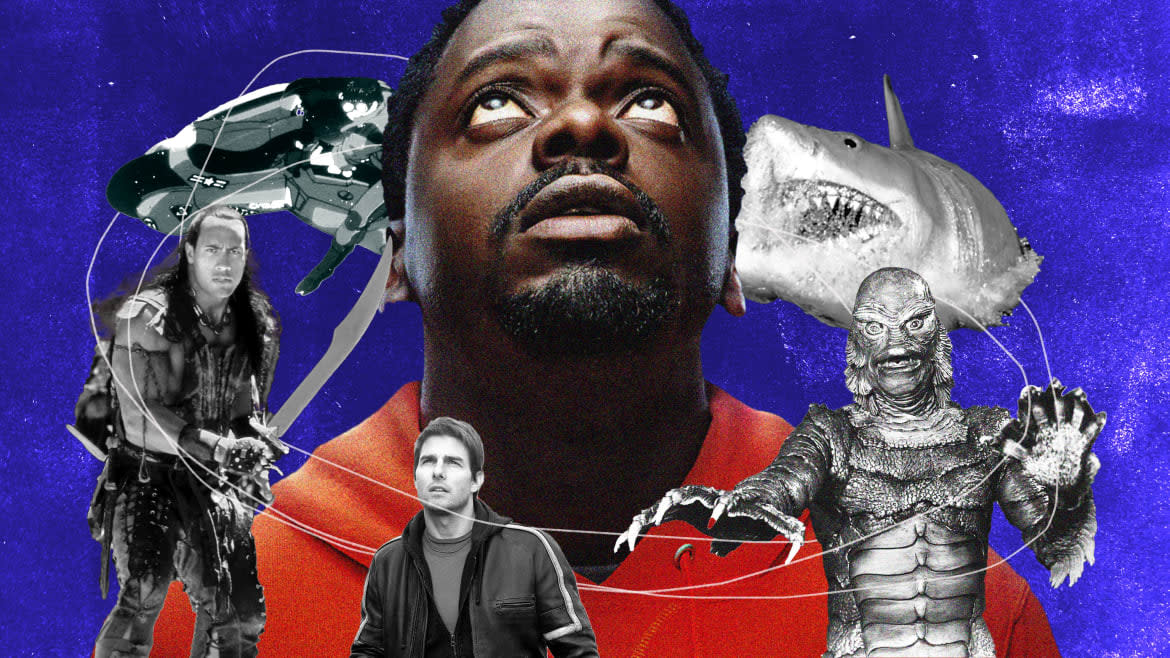
- Oops!Something went wrong.Please try again later.
- Oops!Something went wrong.Please try again later.
- Oops!Something went wrong.Please try again later.
If you’ve seen even one trailer for Nope, Jordan Peele’s latest mind-bending masterpiece, you know that it’s a movie about movies. Not in the traditional sense, of course—there are no technicolor dance sequences on Los Angeles freeways or send-ups of twisted Hollywood dynamics. It does, however, firmly grasp the roots of cinema and how the craft’s real-life origins have paved the way for Nope’s place on multiplex screens across the country.
If that sounds a little too meta, not to worry. Keke Palmer explains it all perfectly in her first scene. “Did you know that the very first assembly of photographs to create a motion picture was a two-second clip of a Black man on a horse?” Palmer’s character, Emerald, asks the production crew at a commercial shoot. “That man is my great, great grandfather.” There’s supposed to be another “great” in there, as her brother, OJ (Daniel Kaluuya), reminds her.
Emerald explains that the crew might know the name of the man who took these photographs, Eadweard Muybridge; inventor of the zoopraxiscope and a pioneer of early photographic motion. But they likely won’t know the name of the Black jockey riding the horse. In reality, the identity of the jockey in Plate Number 626 is unknown, scrubbed from history due to Muybridge ascribing numbers to his human models instead of recording their names. Peele’s fictional twist on this story points out that, while the camera has the ability to document, the very nature of cinema will always leave someone unseen.
Having laid its narrative foundation in cinema’s earliest forms from the start, Nope spends its runtime tipping its cowboy hat to various notable (and not so notable) films that have come before it. Peele, in the words of one Lady Gaga, is unafraid to reference or not reference. And throughout Nope, Peele expands on these references, weaving the audience through a history of cinema with both obvious nods and clever thematic parallels.
Warning: Minor spoilers for Nope lie ahead.
Jordan Peele’s ‘Nope’ Will Blow You Away
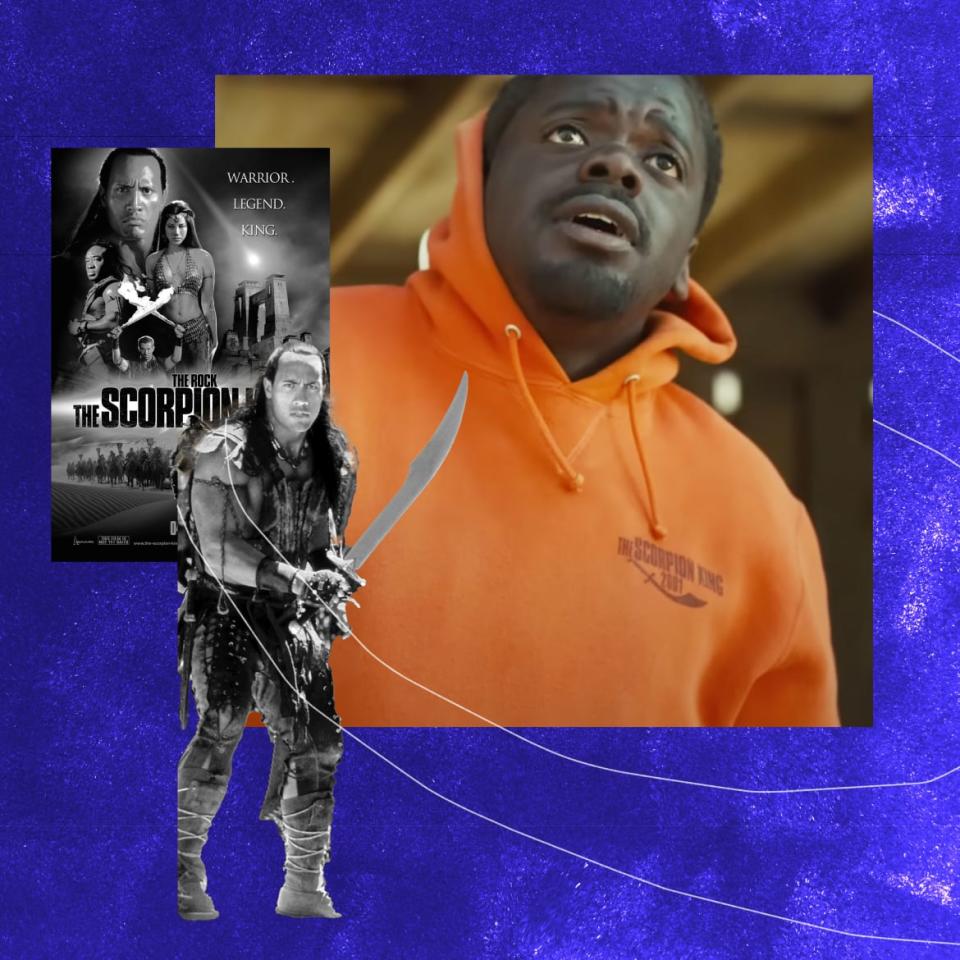
OJ (Daniel Kaluuya) sports his old crew swag from The Scorpion King.
The Scorpion King (2002): Perhaps Nope’s most overt—and definitely its most comical—film reference is to the 2002 spinoff prequel of The Mummy, The Scorpion King. It has been at least a decade since I thought about the existence of this movie, but Nope brought me back to my early, formative days of being transfixed by the Rock’s mountainous, glistening chest in this blockbuster.
The Scorpion King was largely a dud upon arrival, though it was a decent enough action flick to turn the Rock into a bonafide movie star. According to Nope, though, that wasn’t thanks to Haywood’s Hollywood Horses, the fictional family horse wrangling company run by OJ and assisted by Emerald after their father’s death.
When Emerald was younger, their father promised her that she could train her first horse, Jean Jacket, for a movie production. At the last second, her father reneged, bringing OJ along instead. The decision left Emerald feeling discarded and unseen, at least by everyone but her brother.
But in the end, it didn’t really matter: The movie the family worked on was The Scorpion King, and besides it being a flop, the production just ended up using camels instead. The Haywoods still got to keep some sweet Scorpion King crew swag, though, as seen in pivotal scenes later in the film. Look out for DIY recreations popping up on Etsy in 3, 2, 1 ...
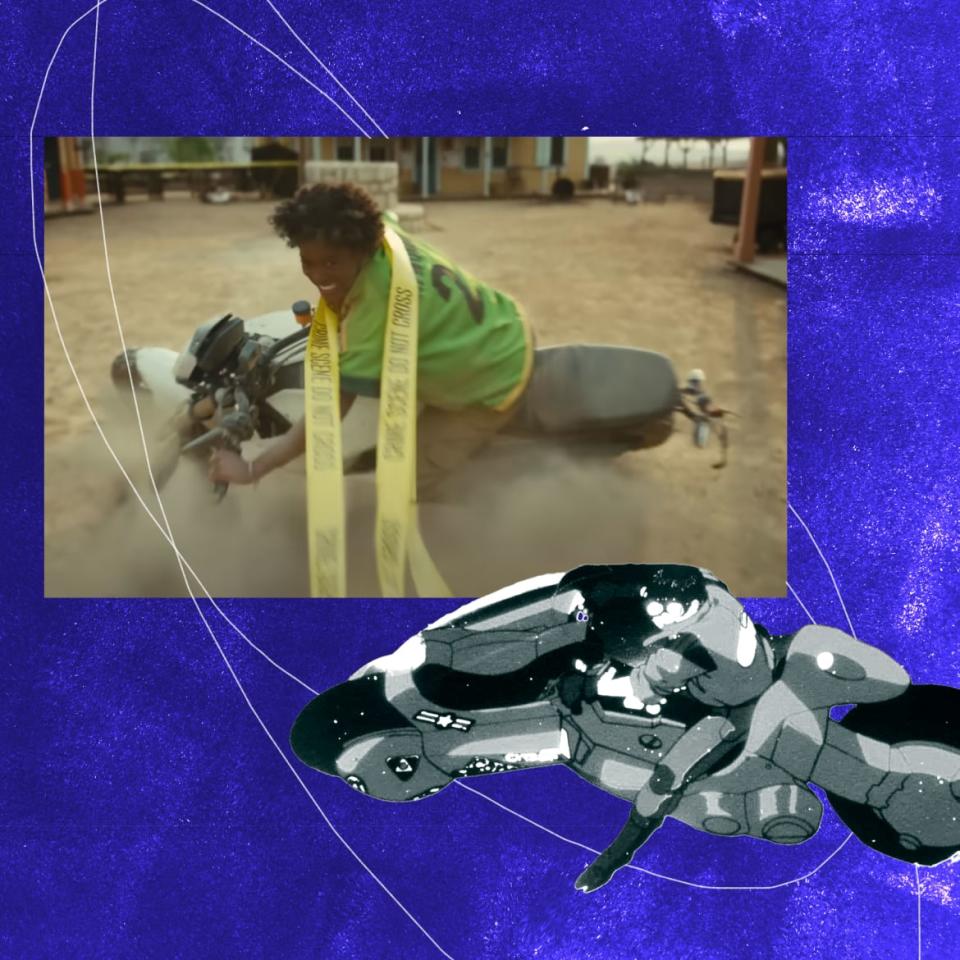
Emerald (Keke Palmer) does the motorcycle slide from Akira.
Akira (1988): Here’s another obvious one that you either already know or you’ve seen homaged 100 different times in other films: the Akira motorcycle slide. The 1988 Japanese anime film has inspired countless writers and directors with its wildly stylish take on cyberpunk futurism. But the film’s most memorable moment is its iconic motorway trick.
In a recent teaser for Nope, eagle-eyed fans instantly recognized a quick shot of Emerald recreating the same slide, draped in yellow police tape. It’s just one of a stack of the film’s badass moments, and a fun tip-of-the-hat from Peele, who cites Akira as one of his favorite films. Peele was even approached by Warner to direct an adaptation of the film, but turned it down in favor of not getting bogged down by intellectual property. Nope’s inclusion of the slide is the perfect injection of IP reverence, a loving tribute that enhances Peele’s smart-as-hell original content. Plus, it’s just really fucking cool.
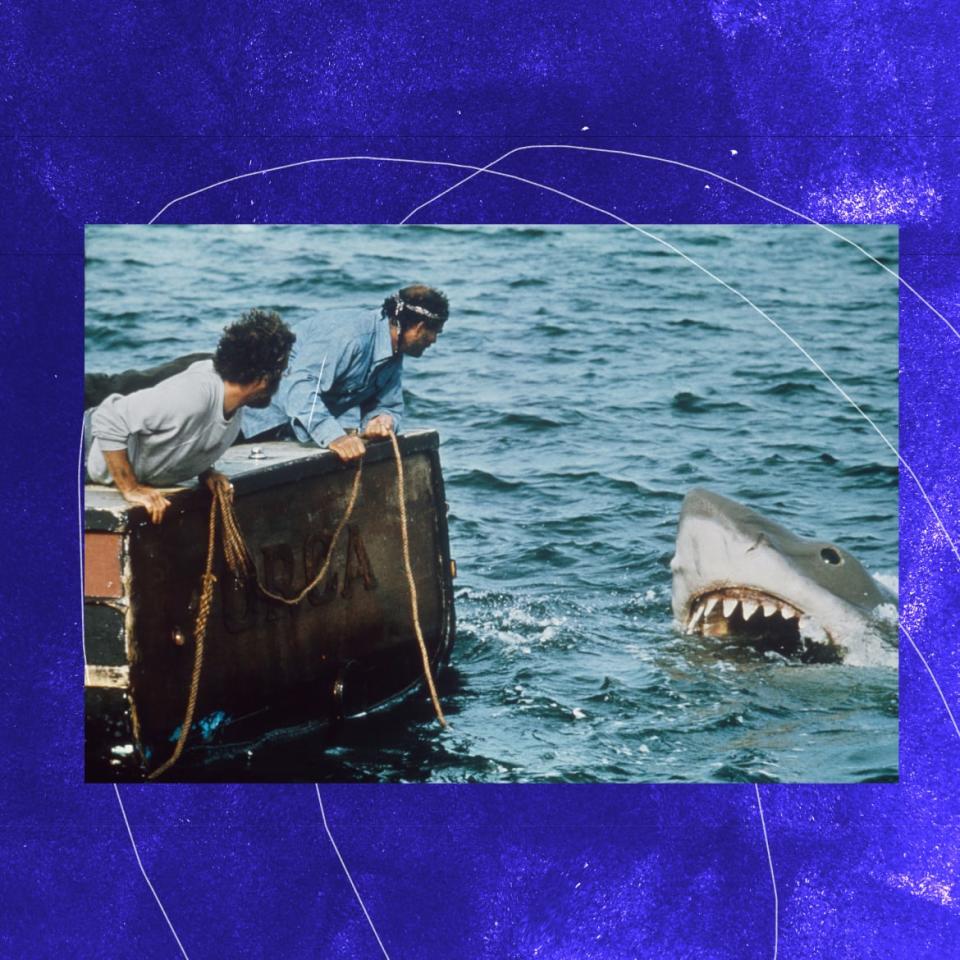
Nope's final act is a near-direct mirror of the climactic sequences of Jaws
Jaws (1975): The parallels between Nope and Steven Spielberg’s game-changing masterpiece Jaws are pretty easy to spot, once you’ve connected the dots. But what’s so great about the way Jordan Peele writes is that, even when you’ve got comparisons nailed down, the nuances of the way they’re embedded into the script continue to unfold long after you’ve gotten home from the theater.
There are several parts of Nope that can be traced back to Spielberg’s filmography, but its connection to Jaws is certainly the most conspicuous. In Nope’s final act, the scrappy team assembled to document the alien creature terrorizing the Haywood ranch creates an elaborate plan to hunt, catch, and stop the monster. It’s a near-direct mirror of the climactic sequences of Jaws, which find Quint, Brody, and Hooper on their boat the Orca, hatching a scheme to hunt and kill the great white lurking in the waters near Amity Island.
Sure, there are plenty of horror and science fiction films that borrow the Jaws plot structure, but not all of them do so as cleverly as Nope’s final 40-minute homage does. What makes the film’s climax so effective and rich in payoff is the way its cinematic references play on the themes introduced in its first half, refracting like light through a prism to square away all of the things Peele is trying to say with his third feature. (By the way, Jaws was Spielberg’s third as well.)
Jaws did gangbusters numbers when it was released in June 1975. It became the blueprint for the modern summer blockbuster and has made generations of beachgoers afraid of the water. Its very existence ignited a fixation on hunting the creatures, endangering a species that's critical to the ecosystem of our oceans. In Nope, Jordan Peele criticizes this kind of lethal fascination with the unknown and how that preoccupation can be triggered by cinema. The similarities between the films are no coincidence: They both use their score and sound design to keep the audience on the edge of their seats, offering brief initial glimpses of their monsters before grand, grisly reveals.
Nope may explore several major themes, but chief among them is its commentary on our obsession with taming natural beasts and our voyeuristic compulsion to watch those attempts through the lens of a summer blockbuster. It’s willing to ask us the question: How thin is the line between documentation and exploitation—and are we made complicit by buying a ticket?
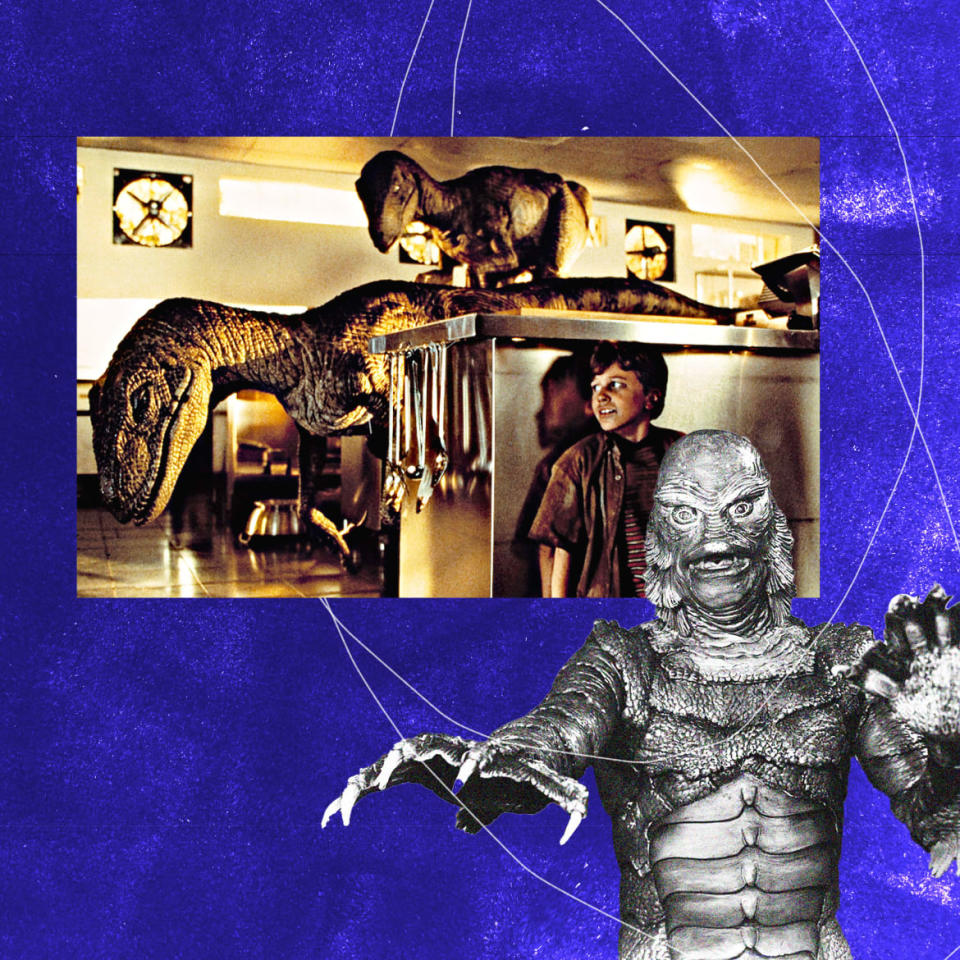
Peele riffs off Creature from the Black Lagoon and a classic scene from Jurassic Park.
Creature from the Black Lagoon (1954) and Jurassic Park (1993): Jaws itself was heavily inspired by Creature from the Black Lagoon, as well as a handful of other early horror films. Creature was a major moment for advancement in underwater photography when it was released in 1954, terrifying audiences with first-person perspective shots from the titular monster as it swam underwater, lurking in the depths after its home was invaded by researchers.
Where Spielberg removed the possibility for the audience to sympathize with the monster in Jaws, Peele keeps it intact in Nope, a la Creature from the Black Lagoon. OJ posits that the creature they’re dealing with doesn’t realize it’s a malevolent force on this world, only acting as a being would in the wild.
Peele once again examines our fixation with curbing animal instincts with the flashback scenes depicting a chimpanzee forced to act in a cheesy 1990s sitcom. When mayhem erupts, we’re treated to and terrified by a scene that mimics Spielbergian tension once again, with a nod to the Jurassic Park scene where raptors stalk the kids in the kitchen. Peele relishes the opportunity to criticize our obsession with taming animals for spectacle and question why we’re shocked when it doesn’t work in our favor. He does this all while asking us if peaceful coexistence is possible when survival is every living creature’s base instinct.
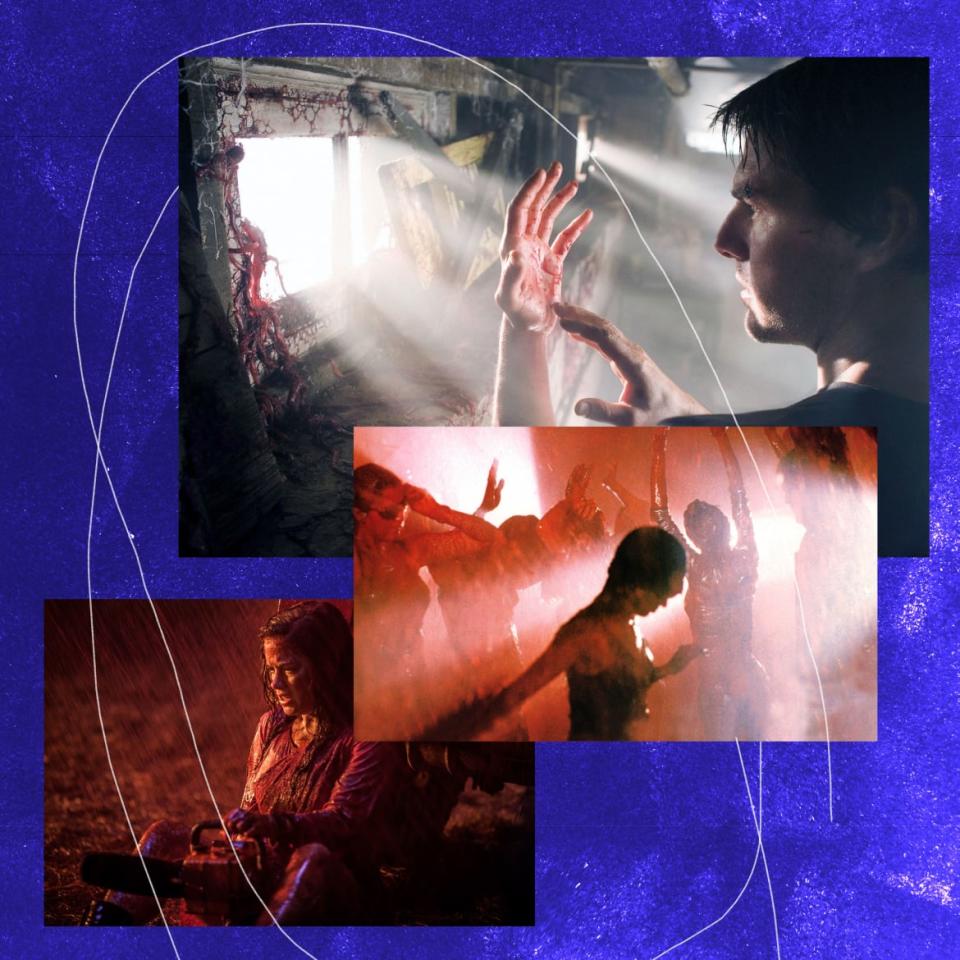
Peele took blood soaked cues from War of the Worlds, Blade, and The Evil Dead.
War of the Worlds (2005), Blade (1998), and Evil Dead (2013): Just when you thought there couldn’t be anything left to mine from Spielberg’s collection of summer blockbusters, a storm cloud gathers overhead. The director’s adaptation of the H.G. Wells novel holds up surprisingly well: It’s a grand spectacle full of horrifically memorable moments, but few are more visceral than Tom Cruise emerging from a basement near the end of the film to find the sky black and the air misted red from blood after alien tripods gobble up every human in sight.
Peele takes this vision and level of fear one step further in a pivotal sequence in Nope, sending blood raining down on the Haywoods’ ranch house after a similar attack. The blood rain is done exceptionally well here, providing an absolutely petrifying set piece in an already tense scene. Nothing feels quite so dark as seeing blood rain down from above, which is probably why Peele borrowed the technique from the opening blood rave sequence in Blade and the climax in the 2013 remake of Sam Raimi’s The Evil Dead—both excellent watches if you’re a fan of being chilled to your bone watching people be covered in bodily fluids!
The Keke Palmer Moment Is Here to Revive Us All
Any good artist can tell you that, while there is plenty of room for original ideas across a vast number of mediums, everything has been done before. What makes something innovative is how it uses those works that have come before it to influence what it wants to say now.
Nope hands its themes to the audience on a UFO-sized platter in the form of easy-to-read cinematic allusions. But instead of being crushed by lofty comparisons to beloved classics, Nope succeeds because of its willingness to reference. Peele’s inclination to pitch his latest up against formative cinematic tentpoles at once expands Nope’s central ideas while critiquing its inspirations with equal parts admiration and hesitation. The result is Peele’s first proper summer blockbuster that skewers the intentions of those that came before it, making it one of the smartest popcorn flicks in decades.
Get the Daily Beast's biggest scoops and scandals delivered right to your inbox. Sign up now.
Stay informed and gain unlimited access to the Daily Beast's unmatched reporting. Subscribe now.

